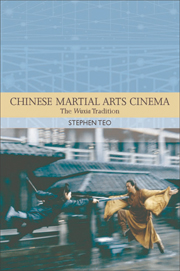Book contents
- Frontmatter
- Contents
- TRADITIONS IN WORLD CINEMA
- Acknowledgements
- Dedication
- Introduction
- 1 Wuxia from Literature to Cinema
- 2 Reactions against the Wuxia Genre
- 3 The Rise of Kung Fu, from Wong Fei-hung to Bruce Lee
- 4 The Rise of New School Wuxia
- 5 The Wuxia Films of King Hu
- 6 Wuxia after A Touch of Zen
- 7 Wuxia between Nationalism and Transnationalism
- Epilogue
- Glossary
- Bibliography
- Filmography
- Index
3 - The Rise of Kung Fu, from Wong Fei-hung to Bruce Lee
Published online by Cambridge University Press: 05 August 2013
- Frontmatter
- Contents
- TRADITIONS IN WORLD CINEMA
- Acknowledgements
- Dedication
- Introduction
- 1 Wuxia from Literature to Cinema
- 2 Reactions against the Wuxia Genre
- 3 The Rise of Kung Fu, from Wong Fei-hung to Bruce Lee
- 4 The Rise of New School Wuxia
- 5 The Wuxia Films of King Hu
- 6 Wuxia after A Touch of Zen
- 7 Wuxia between Nationalism and Transnationalism
- Epilogue
- Glossary
- Bibliography
- Filmography
- Index
Summary
Just as the shenguai wuxia genre took root in Hong Kong's Cantonese cinema after the war, it was rather quickly displaced by a local tradition of martial arts action which came to be called ‘Kung Fu’. The new genre was kicked off by a series of films based on the adventures of the real-life Cantonese martial arts hero Wong Fei-hung (Huang Feihong, in Pinyin). The essential marker of difference distinguishing the kung fu film from the shenguai wuxia film was its emphasis on ‘real fighting’.
Director Wu Pang (Hu Peng in Pinyin) (1909–2000), who created the Wong Fei-hung series, explained that the reason why he forged a new direction in the Chinese martial arts cinema hitherto dominated by shenguai wuxia was because audiences were getting tired of the fantasy routines often shoddily staged and executed. In order to maintain interest, the producers of shenguai wuxia pictures attempted to spruce up their productions with directly animated cartoon images in colour, hand-drawn onto black-and-white prints. Wu writes:
the fight sequences were composed of flying swords clashing with flying knives, whiskers versus gourds, magical ropes catching flying snakes, metal circles colliding with each other and giving off electric sparks. Shenguai and wuxia were mixed together in a pot, and in this way, producers hoped that the genre would survive.
- Type
- Chapter
- Information
- Chinese Martial Arts CinemaThe Wuxia Tradition, pp. 58 - 85Publisher: Edinburgh University PressPrint publication year: 2009



